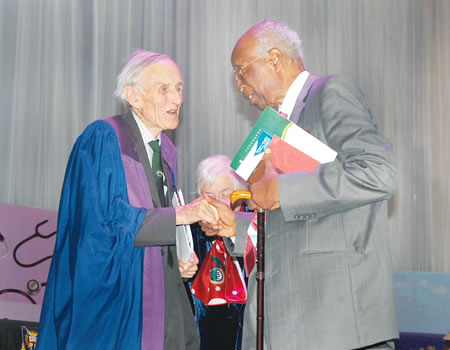From Sleeping Sickness to Ebola
While Cook was in his town hospital, rural Uganda was being ravaged by Sleeping Sickness or human trypanosomiasis, a brutal disease transmitted from animals by the tsetse fly, introduced from Congo into western Uganda by an expedition sent to relieve a British appointed provincial governor, Emin Pasha, from Sudanese “rebels”. What was meant to be part of the fabric of dismantling the cruel and persistent Arab Slave Trade in East Africa and its manacled marches of misery, instead succeeded in dismantling the health of Ugandan villages.
It is nothing new for a non-immune population in Africa to be stricken and almost slaughtered by a new infection whether Sleeping Sickness then, or the viruses of HIV and Ebola now. The response in Uganda was the Sleeping Sickness Commission, a vigorous scientific enterprise mounted by the Royal Society of London, Britain’s foremost scientific institution. It set a precedent for what has to be done today to combat any major infection – harness the best tools of medical science together with the best minds and resolute wills in infectious disease, then Robert Koch and David Bruce, Then, as now, a previously unexposed people, with no acquired herd immunity, was an easy prey to a new organism. Then, as now, conflict was significant in-its spread. Then, as now, applied science was essential to define and overcome the infection. Then, as now, personal courage and dedication were fundamental in its conquest, just as these timeless adornments of character were shown by the health workers who gave their lives in the service of their fellow men and women in the recent Ebola outbreak in Sierra Leone. These scientific martyrs are compellingly described in Getting to Zero, a book by a young British doctor and the young Irish Ambassador who were in Freetown throughout the emergency. You will remember the lady doctor in Lagos, who stemmed a potentially devastating Ebola outbreak in her resolute care of a newly arrived traveller from Liberia who had Ebola. She kept him in her hospital. We honour the memory of the late, and I shall add great, Dr Ameyo Stella Adadevoh.
Early medical training in West Africa
Just as Cook trained medical assistants in East Africa, so in French West Africa, Afrique Occidentale Francaise, a training school was established at Dakar in 1918 which prepared medical assistants and pharmacists, Medecins Ajricains and Pharmaciens Ajricains. There was no formal medical school until what is now Universite Cheikh Anta Diop, produced its first medical graduate in 1961. The Institut Pasteur established its first outpost for disciplined laboratory work at Dakar in 1924, building on a microbiology laboratory set up in 1896.
The reluctance and the inability of-the colonial governments to train medical assistants to become full medical officers, however excellent their work, was awful. Even in the Sudan where the Kitchener College of Medicine opened in 1924 in grand formal buildings, the medical education offered was not to degree level.
The Dakar School was the model for the Yaba School of Medicine, which has a proud history, but its graduates were not regarded as full doctors in spite of training for five years. There was injustice in their salaries too and so an understandable bitterness arose among them. The unintended consequence was to fuel a strong mood for national independence. Many who made significant contributions to health in Nigeria passed through Yaba. Much more should have been done, but the great depression of the 1930s and then the Second World War seriously hindered medical and nursing education in East and West Africa. How essential it was that this University of Ibadan was founded in 1948; how rich has been its contribution to Nigeria and to Africa and how privileged many of us are to have had some part in its early and formative years.
Change and triumph in medicine since 1960
The medicine of today is so different from that which we practised in UCH in 1960. We used to see patients whose faces were not only distinctive as a result of the clean incisions denoting geographical and cultural identity, but which also had the tell-tale pock marks of small pox. Such fortunate survivors provided evidence that, although largely successful, smallpox vaccination campaigns had not been ubiquitous. Africa’s last case was in Somalia in 1977; the world was declared free of small pox in 1980. I saw my last case at a rural hospital in Southern Ethiopia in 1967, appropriately enough in a prisoner. I mention a prisoner because, wherever we worked, prisoners who were brought to hospital were in an appalling state of neglect. Are those training for health care today made aware of the needs of these most excluded members of society?
The discovery and application of vaccines against ancient killers and disablers has been fundamental and will continue to be critically important, because new infections will continue to descend like wolves on the fold in the years ahead. Good science and its commercial development enable us to be thankful now that no longer do children have a paralysed limb from polio, so that some of the poorest become beggars; no longer do distraught mothers watch their newborn babies die rigid from tetanus because, they had not been immunised during pregnancy.
No longer does dry season measles sweep away weaker children, particularly across broad sweeps of African savannah and grasslands during the dry season, when people move among the villages before they are shut in by the rains, and no longer does measles inevitably catalyse malnutrition. Professor David Morley’s work at the Wesley Guild Hospital in lIesha was a landmark in drawing attention to measles, in addition to his pioneering use of Road to Health growth charts.
No longer will those who work in the guinea savannah confront major outbreaks of meningococcal meningitis. The last great epidemic was in 1996 when a quarter of a million people were infected and 25 000 died. Then in 2004 the vaccine MenAfriVac was introduced and 237 million people between the ages of 1 and 29 were vaccinated against the Group A strain. Please allow me to pay tribute to my friend and colleague Sir Brian Greenwood who has been showered with honours and prizes for his work in malaria and meningitis. He too began at UCH Ibadan. He too was one of our team in Zaria with Professor Hilton Whittle who, together with their dedicated training of junior colleagues, laboratory staff and students, did such important field and laboratory research in this ancient but now defeated killer. Brian has applied his formidable intellect and capacity for work to tackle major health care problems, an example to all who seek to publish rather than to contribute.
Malaria
Greenwood has been central, too, in the battle against, and growing conquest of, malaria. What a strategic difference insecticide-treated bed nets, introduced through Brian’s work, have made. Deep scientists have moved further with vaccines.
And, as recently as April of this year, an international team reported that twice yearly azithromycin, an antibiotic used in programmes to prevent trachoma, significantly decreased mortality of children, particularly infants. Malaria need no longer be the killer of infants and the fragmenter of families. In his recent Manson oration, at the Royal Society of Tropical Medicine and Hygiene in London, Brian outlined the progress beautifully but sounded warnings too, including evidence of resistance to permethrin, the vegetable based insecticide for bed nets, but alternatives are being studied.
HIV/AIDS in Southern and East Africa If I were giving this lecture in Southern or East Africa it might have been dominated by HIV and AIDS. I remember a visit to Uganda in the 1990s. We were driving out of Kampala.
Carpenters were busy at the side of the road; there were no tables and chairs for sale, but there was row upon row of freshly cut coffins.
When the lethal virus of HIV swept through countries, it massacred young adults and older ones too, it made widows of young women and orphans of children. The world was aware but South Africa refused to be aware and acknowledge the disease’s transmission. The social effects of this delay will be felt for a generation. Then antiretroviral drugs arrived.
ALSO READ: StayUp Aviation to organise Nigeria, Africa Miss Aviation
Everything changed. Donors gathered to stop the catastrophe.
PEPFAR began operations in 2003. HIV services took precedence and dominated decisions; unfortunately, however, an unintended consequence was that health services were distorted and suffered because health workers left the health ‘ service for an HIV project in which a donor set salaries far above what government posts paid. The pattern of disease changed too, as other infections, notably tuberculosis, took their opportunity to infect those with HIV because their immune system was Impotent.
The discovery of new anti-retroviral drugs, however, has transformed the outlook and prognosis for those living with HIV in South Africa, where the prevalence of the infection is 33 per cent. My colleague Professor Alison Grant, who works in tuberculosis in KwaZulu Natal, says that HIV infection has to be regarded now as a chronic manageable disease. South Africa has to reengineer its primary care services so that no patient has to travel more than 5km to get their free medicines. It is hoped that a small army of lay people, as community care givers, can achieve this.
Billions of dollars needed to apply what is needed for health
The rich world no longer slumbers with a complacent indifference to the opportunities for collaborative work in fighting disease. ‘Great partnerships have been formed to turn the tide of disadvantage; the names of Bill and Melinda Gates are known in many villages in Africa. Their continuing munificence and the 4 billion dollars each year which is
distributed by the Global Fund to fight AIDS, Tuberculosis and Malaria have been literally life-saving. Last month the Global Fund declared that its activities had saved 27 million lives and that in the previous year 17.5 million people received antlretroviral therapy for HIV, 5 million people had been tested and treated for TB and 197 million mosquito nets were distributed to prevent maiaria. over sixty five percent of its expenditure was in Africa.
There is no note of triumphalism in its report; tet me quote the “The progress comes against the backdrop of neW threats to global health. Hoving reduced sharply since the peak of the epidemiC, global HIV infection rates are now declining more slowly, and remain extremely high among key populations in some countries. TuberculosiS is noW the leading couse of death from infectioUS diseases, with 1.7 million deaths per year, and the world is missing 4 .. 1 million cases of rseverv year – cases that go undiagnosed, untreated and unreported. In addition, progres~ against malaria has stolled. In 2016, there were 5 million more cases of malaria than 2015. With growing resistance in drugs to treat malaria and in insecticides for mosquito nets, efforts to control malaria are at stoke.
“Broadly, the Global Fund is investing more in building resilient and sustainable systemS for health – a strategic pillar in efforts to achieve 5ustainoble Development Goal 3, which aims to guarantee healthy lives and wellbeing for all. Building strong report’s warnings.
health systems is also a fundamental element of Global Fund’s efforts to deliver universal access to quality health care for people around the world, while ensuring global health security”.
The Global Fund comments on the threats related to the diseases which it is confronting, but there are other and greater threats to health in Africa.
New methods, new partnerships Not only have new vaccines and new drugs changed health in Africa, but new partnerships in care in the community and in hospitals, and in education and staff development for health, have brought hope and health where despair and disease used to reign, and have catalysed the pursuit of local excellence.
Being lecture delivered by Sir Eldryd Parry at a ceremony to mark Emeritus Professor O.O. Akinkugbe’s “Hanging up the Stethoscope” on Thursday, October 25, 2018 at the International Conference Centre, University of Ibadan.






